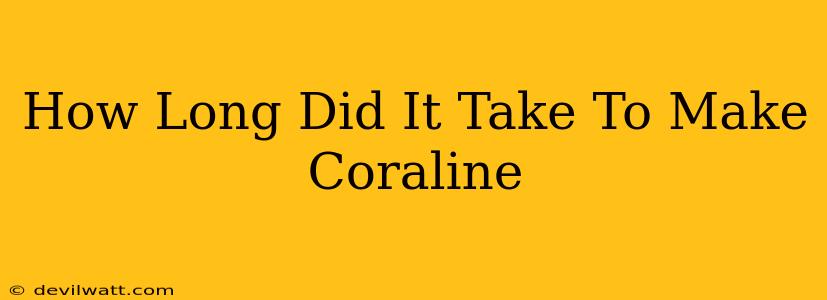Laika's Coraline captivated audiences with its stunning stop-motion animation and chillingly beautiful story. But just how long did it take to bring this masterpiece to the big screen? The answer is far more complex than a simple number. Let's delve into the extensive process and timeline.
The Lengthy Journey of Stop-Motion Animation
Unlike computer-generated animation, stop-motion requires painstakingly meticulous work. Each frame is a photograph of meticulously posed puppets and sets. This incredibly labor-intensive process significantly extends the production timeline. For Coraline, the process was particularly demanding.
Pre-Production: Laying the Foundation (Approximately 1-2 years)
This crucial phase involved:
- Developing the script and storyboards: Adapting Neil Gaiman's novel required careful consideration to translate its dark fantasy into a visually engaging film. Storyboarding helped visualize the scenes and plan the animation.
- Puppet creation: Creating the expressive puppets, including Coraline herself, her parents, and the bizarre inhabitants of the other world, was a monumental task. Each puppet required careful sculpting, rigging, and painting to achieve the desired look and movement.
- Set design and construction: Building the detailed sets, from Coraline's home to the alluring, yet sinister, other world, involved skilled craftsmanship and meticulous attention to detail.
Production: Frame by Frame (Approximately 2-3 years)
This is where the real time investment comes in. The stop-motion animation process involves:
- Shooting: Photographing each frame individually, adjusting lighting, puppet poses, and set elements for subtle movement. This is incredibly slow and demanding work.
- Animation: Animators brought the puppets to life, creating fluid movements and expressive performances through tiny adjustments.
- Special effects: Adding visual effects to enhance the film's atmosphere and create the fantastical elements.
Post-Production: The Finishing Touches (Approximately 6-12 months)
This final phase included:
- Editing: Assembling the individual frames into a cohesive narrative.
- Sound design and music: Creating a soundscape to match the film's tone and enhance its emotional impact. This often involves extensive sound effects and original music composition.
- Visual effects compositing: Combining the animation and visual effects to create the final images.
The Total Time: A Significant Investment
While pinpointing an exact number is difficult, considering the complexity of stop-motion animation, it's safe to estimate that the entire process of creating Coraline, from initial concept to final release, likely took at least 4 to 5 years. This doesn't include any potential delays or unforeseen complications inherent in such a large-scale undertaking. This is a testament to the dedication and artistry that went into bringing this unique film to life.
Keywords: Coraline, stop-motion animation, Laika, movie making, production time, animation process, film production, Neil Gaiman, Coraline movie production time, how long to make Coraline, behind the scenes Coraline.

